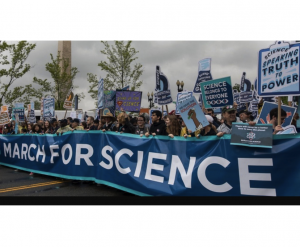FREE FLOW OF INFORMATION
A survey by CPNN
Earthday, April 22, was celebrated in all 50 states of the USA and most of the provinces of Canada.
The central theme for many of the events was the March for Science which affirmed the need for scientific research, especially regarding the problem of global warming, and in reaction against the policies of US President Donald Trump who is cutting support for this research. The largest march was in Washington, D.C. where tens of thousands of people turned out behind the banner shown below.

Click on photo to enlarge
photo credit: Jim Lo Scalzo/EPA
According to ABC News, “… famed American scientist Bill Nye, an honorary co-chair of the event, delivered a speech to a huge crowd in pouring rain. ‘Show the world that science is for all. Our lawmakers must know and accept that science serves every one of us,’ Nye said before shouting out, ‘Save the world!’ Even with the rain, thousands of people packed the Washington Monument grounds for the start of the march Saturday morning. Some were clad in white lab coats while others carried handmade signs calling for funding for scientific research. At least 27,000 Facebook users said they were attending the march in Washington, D.C.”
According to the same source, satellite marches were set for more than 600 cities in addition to Washington and including New York City, Chicago, Seattle, Des Moines, Philadelphia, Atlanta, Austin, Miami, San Francisco, Mobile, Oklahoma City, Rio de Janeiro, Sydney, Paris, Munich, Berlin and many more.
A survey of crowd sizes in 209 cities and towns across the United States was listed as of April 28 in Wikipedia indicating that between half a million and one million people took part in the marches.
(Survey continued in right column)
What has happened this year (2017) for Earth Day?
(Survey continued from left column)
Descriptions and photos of satellite marches for science were published from Victoria, British Columbia, Winnepeg, Manitoba, Flagstaff, Arizona, Berkeley, California, Hartford, Connecticut, Kansas City, Kansas, St Paul, Minnesota, Roswell, New Mexico, Portland, Oregon, Wilkes-Barre, Pennsylvania, Rapid City, South Dakota, Chattanooga, Tennessee, Salt Lake City, Utah, Seattle, Washington and Riverton, Wyoming.
Earthday fairs with educational activities such as booths about ecological initiatives were held in many towns and cities, including Edmonton, Alberta, Unionville, Delaware, Coeur D’Alene, Idaho, Crystal Lake, Illinois, Valparaiso, Indiana, Springfield, Massachusetts, Kalamazoo, Michigan, St. Louis, Missouri, Salem County, New Jersey, Durham, North Carolina and Tulsa, Oklahoma.
Tree planting was a favorite earthday activity, as in Montreal, Quebec, Ashland, Kentucky, Billings, Montana and South Burlington, Vermont.
Another favorite activity was community environmental clean-ups as in Halifax, Nova Scotia, Orange County, California, Marshalltown, Iowa, Southern Maine, Baltimore, Maryland, Martha’s Vinyard, Massachusetts, Ashtabula County, Ohio, Central Falls, Rhode Island, Berkeley County, South Carolina, and Portage, Wisconsin
In many cases events were held by universities, including Arkansas State University, Mississippi State University, Virginia Tech University, West Virginia University and the University of Hawaii
Special internet sites and facebook pages were established to publicize the many earthday events in Hamilton, Ontario, Omaha, Nebraska, Reno, Nevada, Austin, Texas as well as all of Texas and Louisiana.
Participants could choose from a wide range of earthday events according to the calendars published for Alabama, Saskatchewan, Toronto, Ontario, Fairbanks, Alaska, Colorado Springs, Colorado, South Florida , Atlanta, Georgia, New Hampshire and New York, New York.
Especially unique and appropriate was the earthday event in North Dakota, where the horseback riders of the indigenous Dakota Exile Healing Ride celebrated the “Sweet Corn Treaty” that occurred in 1870 with the Chippewa and Sioux tribes. They called for “sharing our homelands and responsibilities to the lands, and water as well as respect for each other’s cultures and traditions by sharing once again as Dakota did”.